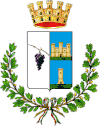Predappio
| Predappio | ||
|---|---|---|
| Comune | ||
| Comune di Predappio | ||
 Palazzo Varano, the town hall of Predappio | ||
| ||
 Predappio Location of Predappio in Italy | ||
| Coordinates: 44°06′N 11°59′E / 44.100°N 11.983°ECoordinates: 44°06′N 11°59′E / 44.100°N 11.983°E | ||
| Country | Italy | |
| Region | Emilia-Romagna | |
| Province | Forlì-Cesena (FC) | |
| Frazioni | Fiumana, Predappio Alta, Rocca delle Caminate, Tontola, Colmano, Fiordinano, Marsignano, Monte Colombo, Monte Mirabello, Montemaggiore, Porcentico, Riggiano, San Cassiano in Pennino, San Cristoforo, San Savino, Sant'Agostino, Santa Lucia, Santa Marina, Trivella | |
| Government | ||
| • Mayor | Giorgio Frassineti | |
| Area | ||
| • Total | 91.39 km2 (35.29 sq mi) | |
| Elevation | 133 m (436 ft) | |
| Population (1-1-2017) | ||
| • Total | 6,297 | |
| • Density | 69/km2 (180/sq mi) | |
| Demonym(s) | Predappiese(i) | |
| Time zone | UTC+1 (CET) | |
| • Summer (DST) | UTC+2 (CEST) | |
| Postal code | 47016 | |
| Dialing code | +39 0543 | |
| Patron saint | Anthony of Padua | |
| Saint day | 13 June | |
| Website | Official website | |
Predappio (Romagnol: La Pré or Dviais) a town and comune in the province of Forlì-Cesena, in the region of Emilia-Romagna in Italy, with a population of 6,297 (1-1-2017). The town is best known for being the birthplace of Benito Mussolini, dictator of Italy from 1922 to 1943. Mussolini is buried at Predappio, and his mausoleum is a local tourist destination, as well as a site of pilgrimage for Fascists.
History
From its origins (possibly Roman) until the 1920s, Predappio was a rural town of modest size, situated on the hills of Forlì. Augustus divided Italy into eleven provinces and Predappio was within the sixth province. It is believed that the town name derives from the installation in those locations of an ancient Roman family: the Appi. The town was accordingly named Praesidium Domini Appi, abbreviated to Pre.DiAppi.
Historically the town developed around the medieval castle, looking down the valley. Along the valley, about 2 kilometres (1.2 mi) from Predappio, the town was known as Dovia (probably a corruption of the local Roman road Duo Via, Two-Way).[1]
Benito Mussolini was born in Predappio in 1883. After a landslide hit the town in the winter of 1923/24 and left many people homeless, the government decided to build a bigger, more prestigious township to celebrate the birthplace of Mussolini, following the architectural dictates of the emerging Fascist regime. Along with the nearby town of Forlì, Predappio was given the title of La Città del Duce ("the city of the Leader").[note 1]
Predappio has become a site of pilgrimage for Italian and other neofascists,[2][3] with this development drawing criticism and protests from anti-fascists.[4]
In April 2009, the town council banned the sale of fascist souvenirs.[5] In 2014, the town's mayor Giorgio Frassineti announced plans to build in the town "a museum dedicated to the history of fascism".[6] The mayor, then standing for re-election as a member of the centre-left Democratic Party, stated that the aim of the council's decision was to have people remember a “fundamental piece of [Italian] history" and that, in this way, "Predappio would become a place for reflection – cutting the town from the hands of those who want to misuse it."[6]
As of early 2016, the museum's construction was still pending, but sale of fascist souvenirs was again permitted in the town.[7]
Twin towns
Notable people
- Benito Mussolini (1883-1945), Italian dictator from 1922 to 1943
- Adone Zoli (1887-1960), Prime Minister of Italy
- Benito Partisani (1906-1969), artist
- Pino Romualdi (1913-1988), politician and journalist
- Ivano Nicolucci (1930-2002), musician
- Andrea Emiliani (1931), art historian
- Vittorio Emiliani (1935), politician and journalist
- Gilberto Cappelli (1952), compositor and painter
- Marino Amadori (1957), cyclist
- Giorgio Canali (1958), musician and singer
Notes
- ↑ Duce: The title taken by Mussolini as Italian dictator
References
- ↑ "Predappio: a Small Village that Changed Italy Forever" by Gabriele Monti, Emilia Delizia, 22 April 2015
- ↑ "Neo-Fascists In Italy Gather For 90th Anniversary Of March On Rome" by Marco Pasqua, Huffington Post, 27 October 2012
- ↑ "Inside the Mussolini Museum" by Barbie Latza Nadeau, The Daily Beast, 26 April 2015
- ↑ An open letter to the Mayor of Predappio by Alfio Bernabei, Searchlight, 14 December 2011
- ↑ "Mussolini's hometown finally bans fascist souvenirs" by Nick Squires, The Daily Telegraph, 17 April 2009
- 1 2 "History of fascism museum to open in Mussolini’s town" by Nick Clark , The Independent, 25 April 2014
- ↑ "Mussolini's Italian hometown plans fascism museum" by Pietro Lombardi, CNN, 17 February 2016
External links
| Wikimedia Commons has media related to Predappio. |
- Official website (in Italian)
- Short presentation of the municipality (in English)

